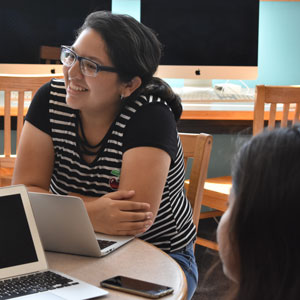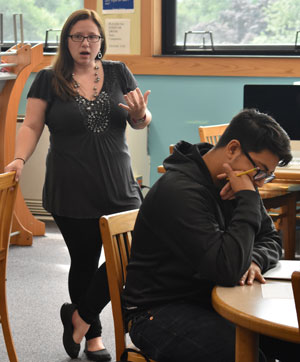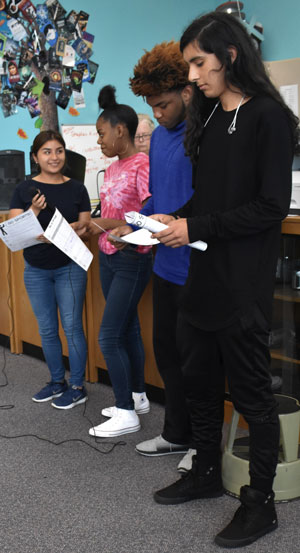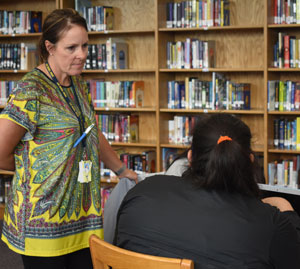Cosplay night. A raffle. “Reb Fest,” complete with music, food, go-karts, a dunk tank and bounce houses.
These were some of the ideas students proposed last week, as seniors in Jody Snyder’s English classes at Lee High School gathered in the second-floor media center to tackle an ongoing problem: poor student attendance at athletic events.
“We’ve never had really full crowds,” said Jason Faasse, now in his fourth year as athletic director for the Rebels. Faasse joined Snyder and Sarah Wood, technology and media integration specialist, to facilitate the exercise.
Students said they also have noticed the lack of school spirit.
“People mostly go to the homecoming game and that’s it,” said senior Brithany Reyes.
Snyder concurs that morale in the stands is lacking, and she would know: in addition to teaching English and elective courses like the senior capstone class, she coaches sideline and competitive cheer at the school.
“As coaches and teachers, we find that student involvement has been decreasing over the years,” she said “We decided that we needed to involve the students instead of just talking amongst the adults.”

The Process
Students opened their school-provided laptops and found a page with some questions: Do you play a sport? What keeps you from attending athletic events? What would make you want to attend? After answering and refreshing the page, they could see the anonymous responses of their classmates. A few responded that after-school jobs them from going to games. Others said they’d go if they knew more friends who did. The answers helped inform the next step: designing a gimmick to boost student participation on the sidelines and in the stands.
Parameters were broad: Students could make their solutions specific to one sport, or applicable to a variety of athletic events. They only needed to hatch a plan and share what kind of support they would need to get it off the ground. And there’s one more thing.
“You will be presenting your idea in front of the class,” said Wood, as groans and looks of disdain spread over the room.
“I’m a little scared” of standing up in front of the class, admitted Angie Rodas.
After all presentations were finished, the ideas were to be compiled and voted on by the entire senior class.

Tackling Concepts
On the surface the exercise was all about boosting attendance at school athletic events. But it’s much more, explained Wood. This type of exercise, known as a “quickfire,” meets the challenge of embedding the “6Cs” of collaboration, communication, content, critical thinking, creative innovation and confidence into the classroom.
Godfrey-Lee Public Schools has embraced the 6Cs, detailed in the book “Becoming Brilliant” as a basis for academic success.
Wood said she learned about quickfire exercises at a conference at Michigan State University last fall. She took the method, used by MSU’s Master of Arts in Education Technology program, and tailored it for use in elementary, middle, and high school environments. Basically, students are given a problem and they must come up with a solution using limited resources and time constraints. Use of the quickfire for Lee High seniors, she said, was driven in part by the fact that they must complete a capstone course where they pick a career, do mentor interviews and gain hands-on experience.
Teachers had noticed that some students struggled with the elements required to complete the capstone.
“When that comes, they freeze,” said Wood. “It’s too many things coming at them. (Snyder) and I were talking last year and decided, ‘something’s got to help get them thinking this way. How can we embed those six C’s into everyday lessons?’ (With quickfire), they have to communicate, they have to collaborate, they have to be creative.”
The culmination, the presentation portion of the exercise, addresses another “C”, said Wood: confidence.
“Kids who wouldn’t speak up suddenly start speaking up,” said Wood. “They’re given that voice. So once they get used to it in a comfortable, relaxed, non-threatening activity like this, then you start seeing it more in the classroom. It’s not necessarily related to their capstone, but they’re forced to think that way.”
The benefit of the exercise is academic in nature, but the ideas that come out of it are major bonus points. Last year, said Wood, students did a quickfire exercise to propose after-school clubs. Some students took the ideas they’d developed in the classroom to the principal, who implemented them. She is hoping for a similar outcome with the latest exercise.

The Pitch
When it came time for students to share their solutions, they presented a range of ideas. Many involved food. Some were inexpensive and easy to implement. Others would require significant funding and permits.
Senior Erick Chavarria’s four-person group hoped to boost participation at soccer matches with an activity they called “Kick-a-Pumpkin”, where participants would get chance to kick a soccer ball at a pumpkin and win prizes for knocking it over.
“I really hope this project gives everyone a slap in the face,” said Chavarria, class president who plans to set an example and attend more events this year. “This is high school and this is one of the places you make the most memories. I want people to look back and say, ‘Yeah, I had a good time.’”
Snyder approved. “I think they’ve got great ideas. It’s nothing that we can’t do,” she said. “I think it’s just getting the right people involved and actually giving them ownership of their ideas. I think we can do some of these things, and I think we’ll see student involvement increase at sporting events.”
Faasse said there are many reasons students don’t come to games, including transportation and work schedules. While the implementation of ideas might not be able to capture all students, he hopes those who don’t attend because their friends aren’t there will change their tune.
Snyder said that it’s more fun for all of the students, especially athletes, if they have their peers there to support them and they hear them in the stands or on the sidelines.
“They play harder, they seem happier,” she said. “It’s just a better environment.”

And the Winner Is…
Two days after the quickfire exercise, all seniors had a chance to vote on their favorite idea to boost attendance at athletic events.
The winning idea was concocted by seniors Myesha Cross, Jacky Jaime, Anaisa Sanchez and Yuri Damian. The group called their idea “Rebel ID.” Under the proposal, students receive free admission to games if they show their student identification card.
After announcing the winning idea, Wood and Snyder reiterated to the students that this is a student-led project, so what happens next is up to them, said Wood. After the quickfire, she added, students came up with even more ideas to boost game attendance, such as Senior night and theme nights.
“They really took off with it,” said Wood.
CONNECT
SNN article: Test-driven curriculum: meet the 6Cs














